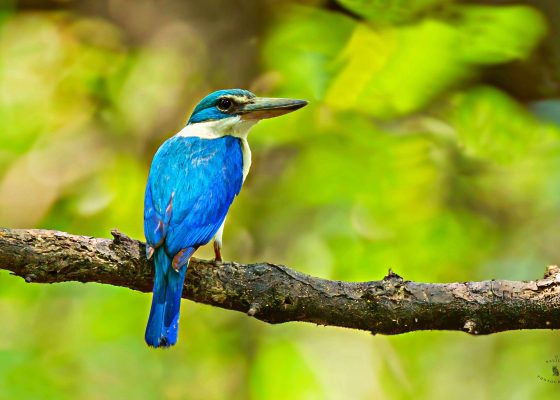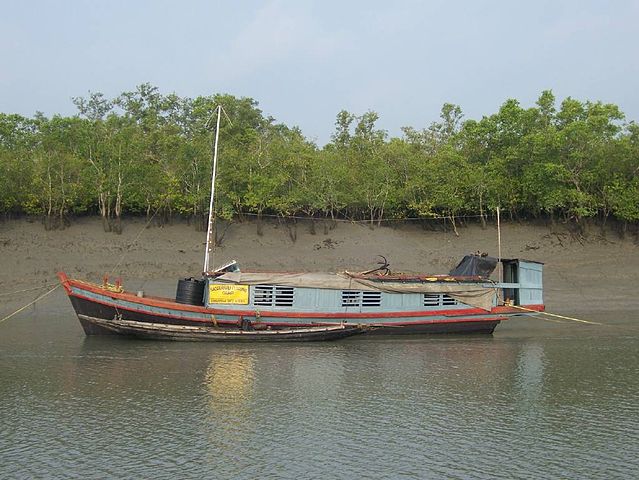The Sundarbans is a magnificent forest, the likes of which you probably haven’t seen before – but, more importantly, it’s the main habitat of one of the planet’s most endangered and threatened species. That makes it an area of significant natural importance, as well as beauty.
And, to help you on your quest to learn more about this Asian mangrove, we have more than a few facts to share with you. Whether or not you’re already an animal lover or a fan of conservation, it’s time to dive deep into some interesting facts about the Sundarbans.
1. It is the largest mangrove in the world.
The Sundarbans is, perhaps most famously, the largest mangrove forest in the world. The area covers approximately 10,000 square kilometres of land and water across India and Bangladesh.
The area can be found in the delta region of the Ganges, Meghna, and Brahmaputra rivers in the region of the Bay of Bengal.
It’s technically split up by waterways and tides, creating miniature islands and split forests – which is, as you might imagine, a fantastic habitat for all kinds of animals to thrive in!
2. The name has an important meaning.
The word “Sundarbans” actually carries a lot of meaning. The word is derived from two other Bengali words – firstly, “Sundar,” which roughly translates to beautiful, and “ban”, which means forest.
So, it’s the “beautiful forest” – a pretty fitting name, by all accounts!
3. It is a world heritage site.
Being the biggest mangrove forest in the world, it should come as no surprise that the Sundarbans is a UNESCO World Heritage Site.
The area is recognised for its unique ecosystem and biodiversity, both of which have become increasingly important, but more on that later!
UNESCO officially recognised the area as a site of importance back in 1997 – though several conservation bodies have been protecting the area for some time since then.

4. It is the home of the Bengal tiger
One of the main reasons that the Sundarbans ecosystem is so important is because it is home to the Bengal tiger. This particular tiger is known for its adaptation to the mangrove habitat and swimming abilities, which are essential for hunting and navigation in the forest’s waterways.
The particular tiger species is said to have around 2,000 to 2,500 left in the wild, with an estimated population of around 200-300 individuals in the Sundarbans alone. This makes the Bengal tiger one of the largest tiger populations in the world – though it is sadly still very small.
Thankfully, the Sundarbans Tiger Reserve was first set up back in 1973. It encompasses an important area of the Sundarbans and is completely dedicated to conserving Bengal tigers and their habitats.
5. It is home to many other species, too.
However, the Sundarbans is not only home to Bengal tigers, of course! In fact, it has an abundance of wildlife species thriving in the area.
For example, it is home to estuarine crocodiles, fishing cats, saltwater crocodiles, spotted deer, Indian pythons, wild boars, water monitor lizards, and various bird species.
There are around 260 different bird species living in the Sundarbans area. It’s not hard to spot wildlife around here; all you have to do is look up!
6. It is a vital habitat for several endangered species.
For many species, the Sundarbans is an absolutely vital area. It serves as a critical habitat for several endangered animals that, many years on, are still being watched over.
Some of the most famous endangered species of the area include the Gangetic dolphin, Irrawaddy dolphin, and the critically endangered river terrapin. Thankfully, the conservation bodies – and UNESCO – protecting the area are doing their bit to prolong the ecosystem and any life within.

7. It serves as a protection for the nations behind it.
One of the most interesting things about the Sundarbans is that it serves as something of a protector for India and Bangladesh, too.
That is to say, the mangrove forests of the area act as a natural barrier against cyclones, tidal surges, and sea-level rise. In doing so, they help to protect the coastal regions of India and Bangladesh from various natural disasters!
Without the Sundarbans, millions of lives would be at stake – which is all the more reason to protect them and the animals that keep its ecosystem thriving!
8. The waters have special powers.
Well, not exactly. In order for the mangrove trees of the area to survive and thrive, they need a very particular kind of water.
In the Sundarbans, freshwater from the rivers mix with saltwater from the Bay of Bengal. In doing so, they create a brackish water environment that is perfect for mangrove trees.
You can’t just feed a mangrove tree from water out of the faucet, unfortunately! They’ve thrived here in the Sundarbans for years, thanks to that perfect brackish mix.
9. It is an area of International Importance beyond UNESCO.
Aside from being a UNESCO World Heritage Site, the Sundarbans is also a Ramsar Wetland of International Importance. But what does that mean?
It means the area has been designated as such due to its critical role in conserving biodiversity and supporting migratory bird populations.
The area also provides important livelihoods for the local communities! For example, local people who live and work close by need the area for fishing, honey collection, timber extraction, and forest products.

10. Multiple indigenous communities still live in the area
One of the most important facts about the Sundarbans is that it remains inhabited by various indigenous communities – meaning there are more than just animal lives that depend on this wonderful forest region.
Among the indigenous communities are the Munda, Teli, Bagdi, and Mahato tribes. All of the tribes have naturally adapted to life in the mangrove forest for centuries – and they have no desire to change this.
11. The area is also well known for its honey.
Yes—believe it or not, many people love the Sundarbans for its honey—mainly thanks to the unique-tasting produce emanating from local bees.
It is particularly well-known for its traditional honey collection practices. During the collections, honey hunters must confront the forest’s dangers to collect honey from wild beehives! It’s definitely not an easy practice and is not meant for the faint of heart!
All the more reason, then, why the forest’s honey has such a legendary reputation.
12. Traveling by boat is the way to go around the Sundarbans.
Due to the Sundarbans having a natural network of tidal rivers, creeks, and channels, these are used as the main roads for the people in the area.
The water networks are navigable by small boats, which are used by locals for transportation, fishing, and even for various eco-tourism activities. Yes – if you want to visit the region, it’s possible to navigate it through water tours!
13. It has been a biosphere reserve for decades.
The Sundarbans Biosphere Reserve was designated in 1989. This extensive conservation area includes the Sundarbans Tiger Reserve, as mentioned above, as well as other forest areas and buffer zones.
The goal of this reserve has always been to conserve biodiversity while promoting sustainable development in the area. So far, so good – and long may it continue…
14. The area is, however, under threat.
As is tragically the case with various natural areas around the world, the Sundarbans is threatened by various human activities, such as population growth, urbanization, and industrial development in surrounding areas.
These alarming human activities in the area are causing deforestation, illegal poaching, habitat degradation, pollution, and global warming.
These all equally pose significant challenges to the area’s and its inhabitants’ conservation. That is why learning how to better protect and preserve the area is paramount. It’s not an area that we can, at least for now, leave to get better on its own.
15. The natural barrier is failing.
As mentioned above, the Sundarbans has, and still does serve as a sort of barrier for the regions behind it, protecting them from certain natural disasters. India and Bangladesh need the Sundarbans!
However, due to global warming and the increasing sea-level rise, the frequency and intensity of cyclones and storms have started to seriously threaten the Sundarbans ecosystem.
Tragically, they are leading to the erosion of mangrove forests and even the loss of habitat for wildlife. That could, in time, spell disaster for nearby human communities, too.

16. The Sundarbans plays an important role in various economies.
Due to its natural resources, it may come as no surprise that the Sundarbans is a very important area for multiple economies!
That is, of course, to say that the Sundarbans plays a crucial role in the economy of Bangladesh and West Bengal. The area helps to contribute to fisheries, agriculture, tourism, and certain eco-friendly industries.
The area is also home to various traditional medicinal plants used by local communities. This contributes to the area being of vital importance for healthcare and cultural practices for various peoples.
17. It is popular among tourists.
As you can imagine, the naturally stunning Sundarbans is quite the tourist magnet! The area attracts visitors from around the world who come to explore its unique biodiversity, scenic beauty, and cultural heritage.
The Sundarbans offers all kinds of wild opportunities for wildlife watching, bird photography, boat cruises, and cultural experiences with local communities.
And, while certain forms of tourism can be dangerous for natural areas, it is important for as many people as possible to learn about the area, and, specifically, about its importance to the world. The goal of course is to encourage as many people as possible to help protect the area.
18. The area has its own National Park, too!
Located in the Indian part of the Sundarbans, you will find the Sundarbans National Park.
The area is a designated tiger reserve and biosphere reserve. It is also one of the most popular tourist destinations in the area!
That is because the National Park offers various opportunities for wildlife safaris, birdwatching, and eco-tourism. So, if you would like to take a look around the area for yourself, remember to be respectful and to clean up after yourself as you go.

19. It is also home to various mangrove tree species.
Although many of us tend to think of mangrove trees as being all the same, they are most definitely not! And, interestingly, the Sundarbans is home to not one, nor two, but many different mangrove tree species!
In the area, you can find Gewa (Excoecaria agallocha), Sundari (Heritiera fomes), Keora (Sonneratia apetala), Goran (Ceriops decandra), and Baen (Avicennia officinalis) mangrove trees! If you happen to be in the area, try spotting the difference between them!
20. The Sundarbans is nothing without its trees.
Aside from being beautiful, the mangrove trees are of the utmost importance to the area.
As seen above, the mangrove forests provide a certain coastal protection for the regions behind them, but they do even more than that.
Mangrove forests also provide carbon sequestration, water filtration, and support for fisheries in the local areas! These trees are definitely not to be underestimated – all the more reason, then, to fight against them being felled by local companies!
21. It is a birdwatching haven.
The Sundarbans is home to about 120 fish species, 42 mammal species, numerous reptile and invertebrate species, and, as mentioned, around 260 bird species.
In fact, the area is known for being a veritable haven for birdwatchers! It experiences multiple migratory bird species visiting the forest during the winter months, including various species of herons, raptors, egrets, and kingfishers.

22. It is an inspiring area!
The Sundarbans is also believed to have inspired various artists, across multiple industries.
In fact, the area is said to have inspired the setting of the famous novel “The Hungry Tide” by Amitav Ghosh.
The novel explores the complicated relationship between humans and the natural environment in the region. A topic that, of course, continues to be highly relevant to this day.
23. It also has links to mythology.
Given how unique the area is, it is only natural for it to have been linked to multiple folklore and mythological tales!
For example, there are many local legends about the goddess Bonbibi. She is believed to protect the forest and all of its inhabitants from harm.
24. The area is closely monitored.
Currently, the Sundarbans is subject to regular monitoring and research by scientists and conservationists.
The goal for all of these professionals is to better understand the area’s ecology, to better address the various threats surrounding it, and to develop strategies for its sustainable management.

25. The area has a Reserve Forest, too.
In 1875, the Sundarbans Reserve Forest in Bangladesh was established. It was one of the earliest protected areas in the Indian subcontinent!
The goal at the time was to conserve the area’s valuable natural resources. The goal remains the same to this day, particularly as, given what we’ve discussed above, the area is still very much under threat.
26. The area is a genuine symbol.
Despite the various threats surrounding it, the Sundarbans continues to survive, and thrive. It is a unique area in the world filled with fascinating creatures, traditions, and natural remedies.
And, due to the threats surrounding it and the area’s ability to continue, the Sundarbans has become a veritable symbol of resilience and adaptation.
That being said, the area cannot continue to thrive, or indeed survive, if more of us do not take action to help protect it. And, again, due to its natural importance to the various species living in it, and the areas it protects behind it, its continuation is vital.
27. You can explore virtually all of the forests.
It’s said that boat tours across the Sundarbans help tourists and local people reach every last corner of the land. The reason for this, of course, is simple – to raise awareness of the beauty of the region, and to ensure people see as much of this gorgeous, yet sadly threatened region, as possible.

FAQs About The Sundarbans
Why is the Sundarbans so famous??
The Sundarbans is an area that has become increasingly famous notably for being the home to certain endangered species. For example, it is home to the Royal Bengal Tiger, Irrawaddy dolphins, the endemic river terrapin, and more!
Is the Sundarbans in West Bengal or Bangladesh?
The Sundarbans National Park is located in West Bengal, in India. However, about 60% of the Sundarbans are in Bangladesh.
How many tigers are there in the Bangladesh Sundarbans?
It is believed that there are only about 114 tigers in the Bangladesh Sundarbans. Hence, why they are such an endangered species – and, unless we continue conservation efforts, these numbers are only likely to dwindle further.
Do you know any fun facts about the Sundarbans? Share them in the comments below!








